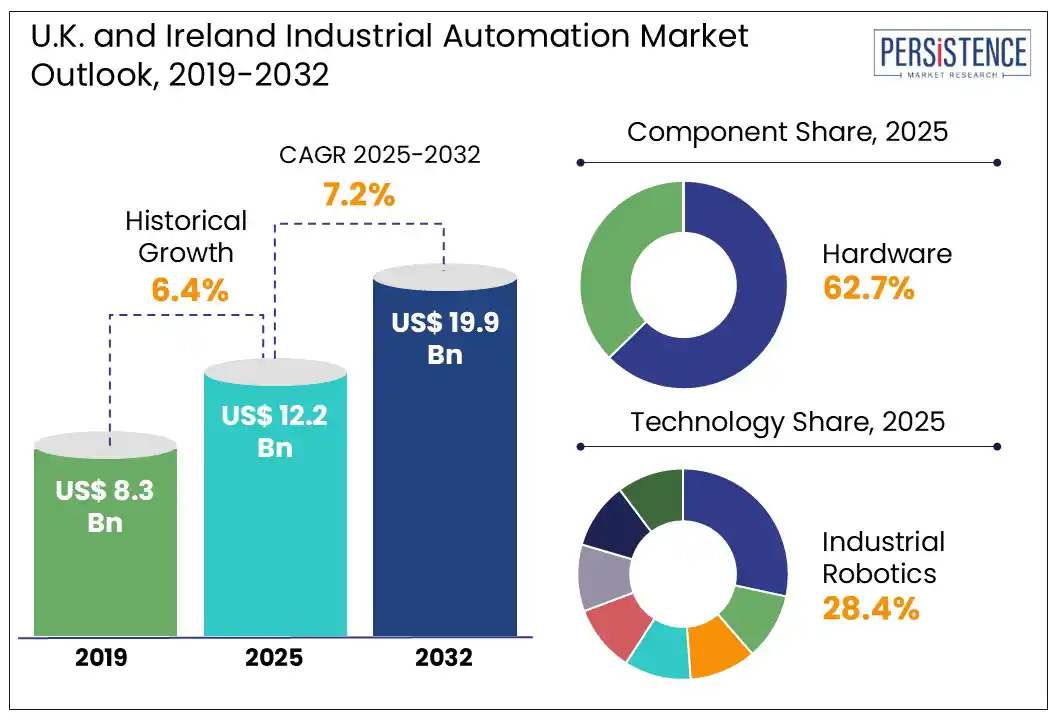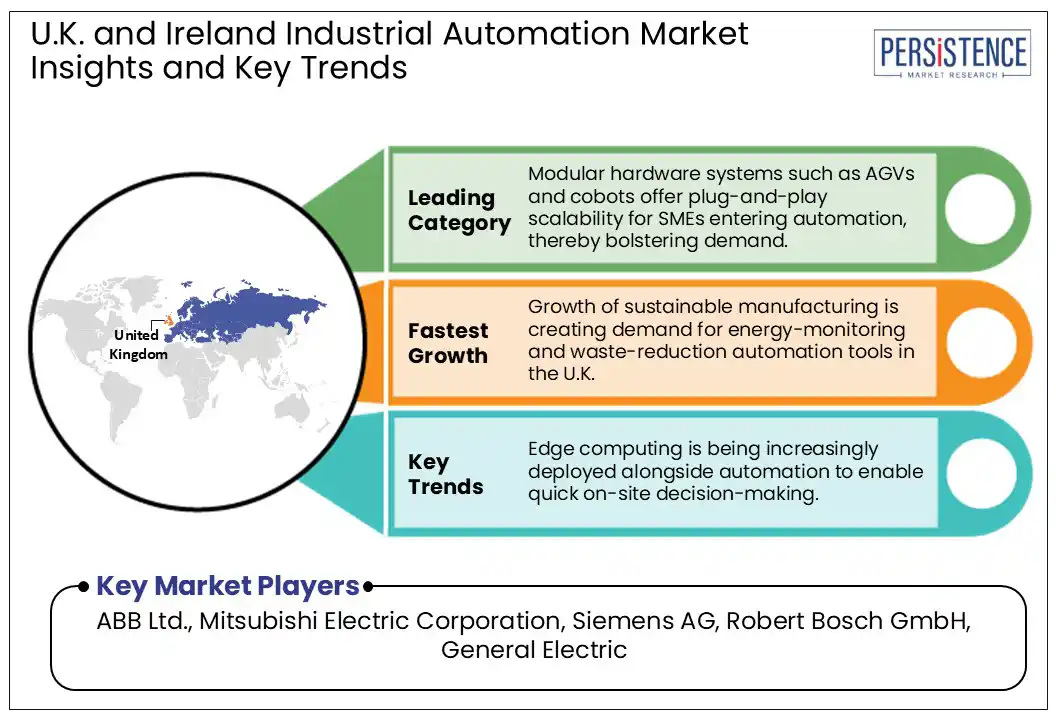ID: PMRREP35466| 148 Pages | 7 Jul 2025 | Format: PDF, Excel, PPT* | Industrial Automation

The U.K. and Ireland industrial automation market size is likely to be valued at US$ 12.2 Bn in 2025 and is estimated to reach US$ 19.9 Bn in 2032, growing at a CAGR of 7.2% during the forecast period 2025-2032.
The U.K. and Ireland industrial automation market is entering a transformative phase, backed by innovative manufacturing ambitions as well as an urgency to counter labor shortages and energy volatility. The market is currently shifting through strategic investment, sector-specific innovations, and grassroots adoption, specifically in pharmaceuticals, food production, and logistics sectors. Government-backed initiatives are not only funding digital upgrades but also encouraging the uptake of robotics, AI, and IoT at the Small and Medium-sized Enterprise (SME) level. From AI-enabled quality checks in automotive plants to 5G-powered process automation, the market is gradually redefining smart manufacturing.

Key Industry Highlights
|
Market Attribute |
Key Insights |
|
U.K. and Ireland Industrial Automation Market Size (2025E) |
US$ 12.2 Bn |
|
Market Value Forecast (2032F) |
US$ 19.9 Bn |
|
Projected Growth (CAGR 2025 to 2032) |
7.2% |
|
Historical Market Growth (CAGR 2019 to 2024) |
6.4% |
The U.K. and Ireland industrial automation market growth is predicted to be augmented by the surging emphasis on offsetting high operational costs, energy bills, and acute labor shortages. In the U.K., manufacturers faced a 12.3% increase in energy costs between 2022 and 2023, found an online report. This is encouraging firms to adopt smart automation systems that reduce energy waste and improve resource efficiency. For instance, Princes Group, a U.K.-based food producer, implemented an automated Clean-In-Place (CIP) system in its beverage plants. It helped the company to cut water usage by 20% and cleaning cycle times by 15%, leading to substantial cost savings.
In Ireland, the pharmaceutical and medtech sectors are using robotics and process automation to meet rising global demand without expanding headcount, states Persistence Market Research. Boston Scientific’s Cork facility recently adopted novel machine vision and robotic pick-and-place systems to reduce packaging errors and downtime. It achieved an 8% boost in Overall Equipment Effectiveness (OEE). Similarly, local SMEs participating in the Irish Manufacturing Research (IMR) pilot programs reported up to 25% reduction in waste and 10 to 12% surge in throughput within one year of automation integration.
In both the U.K. and Ireland, industrial automation and control systems are facing hindrances due to legacy infrastructure, fragmented digital maturity among SMEs, and surging socioeconomic concerns over job displacement. A 2023 report by Make U.K. highlighted that nearly 41% of small manufacturers in the country still rely on outdated equipment incompatible with modern automation interfaces. This has been creating integration bottlenecks that require costly custom retrofits. It is prevalent in aging food processing and textile factories located in areas such as Yorkshire and Lancashire, where capital constraints delay transitions to smart systems.
In Ireland, similar issues persist among SME-heavy sectors such as precision machining and agri-food processing. While multinational firms benefit from automation-ready cleanrooms and innovative IT infrastructure, several indigenous manufacturers struggle with basic digitization. According to Irish Manufacturing Research (IMR), less than 30% of small manufacturers have implemented even basic sensor networks or MES platforms. It has hindered their ability to deploy more complex automation, including predictive maintenance or AI-guided robotics.
The rollout of 5G wireless networks is opening new avenues for industrial automation in the U.K. and Ireland by enabling ultra-low latency, real-time data transmission, and massive device connectivity. In the U.K., the Manufacturing Technology Center (MTC) in Coventry has launched a 5G-enabled testbed in collaboration with BT and Ericsson. It aims to demonstrate real-time robot control and augmented reality support in factory environments. The facility has exhibited that 5G can reduce robotic control latency to below 10 milliseconds, enabling use cases such as remote machine maintenance and mobile robot fleets for intra-logistics.
Industries in Ireland are also experimenting with private 5G networks to improve manufacturing agility. In 2024, a few companies used 5G to connect mobile sensors, Autonomous Guided Vehicles (AGVs), and digital twins across their production lines. This resulted in a 30% improvement in real-time quality monitoring and a 25% reduction in line changeover times. These early results are positioning private 5G as a foundation for flexible batch manufacturing, particularly in Ireland’s pharmaceutical and food sectors where production agility is significant.
By component, the market is bifurcated into hardware and software. Among these, the hardware segment will likely account for nearly 62.7% of the U.K. and Ireland industrial automation market share in 2025 due to the dominance of manufacturing sectors that rely heavily on physical machinery, robotics, and control systems for productivity gains. In the U.K., automotive, food processing, and aerospace industries are heavily dependent on Programmable Logic Controllers (PLCs), robotic arms, and Human-Machine Interfaces (HMIs). Similarly, in Ireland, the pharmaceutical sector requires high-precision automation hardware to meet stringent compliance and quality demands.
Software has become a key component owing to the rising demand for flexible manufacturing, real-time process optimization, and data-driven decision-making. Ireland’s manufacturing sector is increasingly adopting Manufacturing Execution Systems (MES) and SCADA platforms to ensure traceability, regulatory compliance, and production adaptability. In the U.K., the Advanced Manufacturing Research Center (AMRC) in Sheffield runs software-centric pilot projects with local SMEs to implement condition-monitoring systems.
Based on technology, the U.K. and Ireland industrial automation market is segregated into industrial robotics, machine vision systems, control systems, artificial intelligence and machine learning, Industrial Internet of Things (IIoT), Advanced Process Control (APC), and Human-Machine Interface (HMI). Out of these, the industrial robotics segment is projected to hold approximately 28.4% share in 2025 due to acute labore shortages, demand for precision in high-value manufacturing, and shift toward small-batch production lines. Another key factor is the availability of collaborative robots (cobots) that are cost-effective, safe, and easy to integrate.
HMI technology is also gaining impetus owing to the rising complexity of production environments as well as the requirement for real-time visibility, intuitive control, and remote operability. As industries in both countries transition from legacy PLC-based setups to smart systems, HMI solutions are enabling operators to manage multiple assets and processes with minimal training. In high-compliance sectors, HMIs are becoming significant for traceability and audit readiness, thereby boosting demand.

The U.K. market is undergoing a strategic shift, propelled by the push for decarbonization and labor shortages. According to the International Federation of Robotics (IFR), the U.K. continues to lag behind other G7 countries in robot density, with just 111 robots per 10,000 manufacturing employees as of 2023, compared to Germany’s 397 and Italy’s 224. This gap, however, is narrowing, specifically in aerospace and pharmaceutical industries. In these industries, automation adoption is accelerating due to skill shortages and export-oriented demands.
The U.K. government's Made Smarter initiative is further pushing automation uptake among SMEs by subsidizing digital transformation projects and offering access to industrial automation expertise. Hence, regions such as the Northwest and the Midlands are emerging as automation growth hubs. Engineering firms in Greater Manchester, for instance, have reported up to 15% productivity gains within 12 months of integrating industrial IoT platforms and robotics in CNC machining lines under the Made Smarter program.
Ireland is progressing rapidly under the tailwinds of its Industry?4.0 strategy, targeted research and development investments in medtech and pharmaceuticals, and surging SME uptake. Launched in 2020, Ireland’s Industry?4.0 roadmap aims for full adoption by 2025. It is supported by €6 Bn as well as EU digital research and development funds and public-private ecosystem building. While still early in its transition, thought leaders are laying groundwork for Industry?5.0 standards, especially in user?centric medtech labs.
Ireland’s pharmaceutical giants, including Boston Scientific, Eli Lilly, and MSD, are integrating robots into lab automation, quality control, and packaging. One case study reports robotics in pharma driving onshoring and AI?powered healthcare algorithms. Noreside Engineering highlights robotics transforming Ireland’s pharmaceutical manufacturing landscape. With nearly 230,000 employed in manufacturing, the country leverages a robust talent base and climate-focused digital strategy. Key automation integrators have set up operations in Ireland, serving life sciences with hundreds of engineers and global reach.
The U.K. and Ireland industrial automation market is characterized by a mix of global automation giants and an expanding network of regional system integrators as well as start-ups. Key companies are strengthening their presence with their long-standing industrial relationships, particularly in pharmaceuticals, food and beverage, and energy sectors. However, what distinguishes the U.K. and Ireland is the significant role played by local integrators who specialize in retrofitting legacy infrastructure with modern automation systems. Cybersecurity in operational technology environments is also emerging as an important differentiator among automation vendors.
The U.K. and Ireland industrial automation market is projected to reach US$ 12.2 Bn in 2025.
Increasing deployment of edge computing and surging development of digital twin technology are the key market drivers.
The U.K. and Ireland industrial automation market is poised to witness a CAGR of 7.2% from 2025 to 2032.
Cross-sector partnerships with academic institutions and growth of sustainable manufacturing are the key market opportunities.
ABB Ltd., Mitsubishi Electric Corporation, and Siemens AG are a few key market players.
|
Report Attribute |
Details |
|
Historical Data/Actuals |
2019 - 2024 |
|
Forecast Period |
2025 - 2032 |
|
Market Analysis Units |
Value: US$ Bn/Mn, Volume: As Applicable |
|
Geographical Coverage |
|
|
Segmental Coverage |
|
|
Competitive Analysis |
|
|
Report Highlights |
|
|
Customization and Pricing |
Available upon request |
By Component
By Automation Type
By Technology
By Industry
By Country
Delivery Timelines
For more information on this report and its delivery timelines please get in touch with our sales team.
About Author